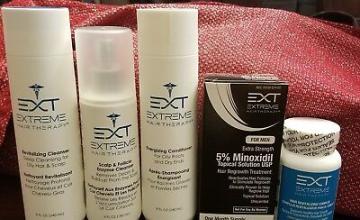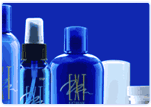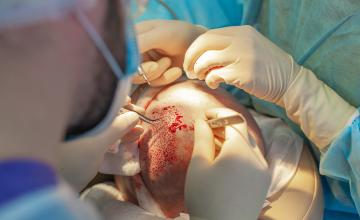Extreme Hair Therapy (EXT)

 Is this hair loss treatment effective?
Is this hair loss treatment effective?
Extreme Hair Therapy (EXT) for thinning hair is a 5 "step" hair loss treatment solution created by Hair Club that claims not only to rejuvenate your hair, but "rejuvenate your life". Making claims to be FDA approved, EXT claims to stimulate hair regrowth in thinning areas by keeping hair in the anagen (hair growth) phase longer.
Balding men and women seeking hair loss solutions should be careful to do their due diligence in researching all products they are considering. Is this one of the hair loss products that really works to treat baldness? Can Extreme Hair Therapy really deliver what it promises?
Below we take a look at each of the 5 “steps” and separate treatments and analyze whether or not EXT can remedy alopecia in men and women.
What is the 5 Step Process of Extreme Hair Therapy?
Step One: Moisturizing or Revitalizing Cleanser
This moisturizing shampoo is rich with vitamins and works to cleanse the scalp. Though it claims to revitalize and strengthen thinning hair, the ingredients are not listed on their website. Many hair rejuvenators and thickening agents (commonly referred to as volumizing shampoos) help to make hair appear thicker as they take on hydration and swell. Unfortunately, these thickening agents do nothing to stop the progression of male pattern baldness, even if it temporarily makes the hair shaft appear fatter.
Step Two: Enzyme Scalp Cleanser
Claiming to be a “new breakthrough”, this organic formula removes sebum oils that can sometimes hinder hair growth. Though sebum buildup, excessive dandruff, and scalp dermatitis are sometimes responsible for certain non-genetic types of balding such as diffuse alopecia or telogen effluvium, it does not promote androgenic alopecia (hereditary male or female hair loss).
Step Three: Energizing Conditioner
Adding nutrients such as proteins and wheat amino acids, this conditioner helps to promote a healthy scalp and hair growth. It should be noted that nothing in this step claims to stop hair loss or stimulate hair regrowth.
Step Four: Hair Revitalizing Complex
This dietary supplement containing Vitamins B3, D, and E, Biotin, saw palmetto and nettle root is taken twice daily, once in the morning and once at night. Some of these ingredients can also be found in several other hair loss products such as Provillus, Procerin, and Avacor.
Though some of these ingredients work to treat benign prostatic hyperplasis (BPH) in men by inhibiting DHT (the hormone responsible for female and male pattern baldness), no formal clinical studies have been performed on successful hair loss treatment. It should be noted that tocotrienol molecules in Vitamin E may effectively treat alopecia but its counterpart tocopherol (commonly found in alternative herbal hair loss treatments such as HairMax MD), is not supported. Additionally, because there are no regulations on herbal medications in the United States, the daily recommended value and dosage in Extreme Hair Therapy is based on something other than FDA regulation.
Step Five: Minoxidil (2% or 5%)
Minoxidil (the active ingredient in Rogaine and Xandrox) is an FDA approved hair regrowth formula and is used by many balding men and women with great success. Because Extreme Hair Therapy includes this, they are legally allowed to claim it to be FDA approved.
Costs:
Unfortunately, this information is not available on the Hair Club website. Upon calling the toll free number for this information, we are told that we must schedule a consultation with a Hair Club specialist. Customer service representatives are apparently not provided with this information.
Side Effects and Warnings:
No EXT side effects are reported on the Hair Club website however, Minoxidil may cause scalp irritation or redness, chest pain, a rapid heartbeat, faintness, swelling of the hands and/or feet, and unwanted facial hair growth. Be sure to discuss the use of herbal medication with your physician before taking them. Saw Palmetto should be avoided by pregnant women with hair loss.
Conclusions:
The only FDA proven ingredient in Hair Club’s Extreme Hair Therapy hair loss treatment is Minoxidil. Though Saw Palmettoand nettle root may be effective in treating men with an enlarged prostate by inhibiting DHT, no formal tests have been performed on them.












 Is it Effective in Treating Baldness?
Is it Effective in Treating Baldness?